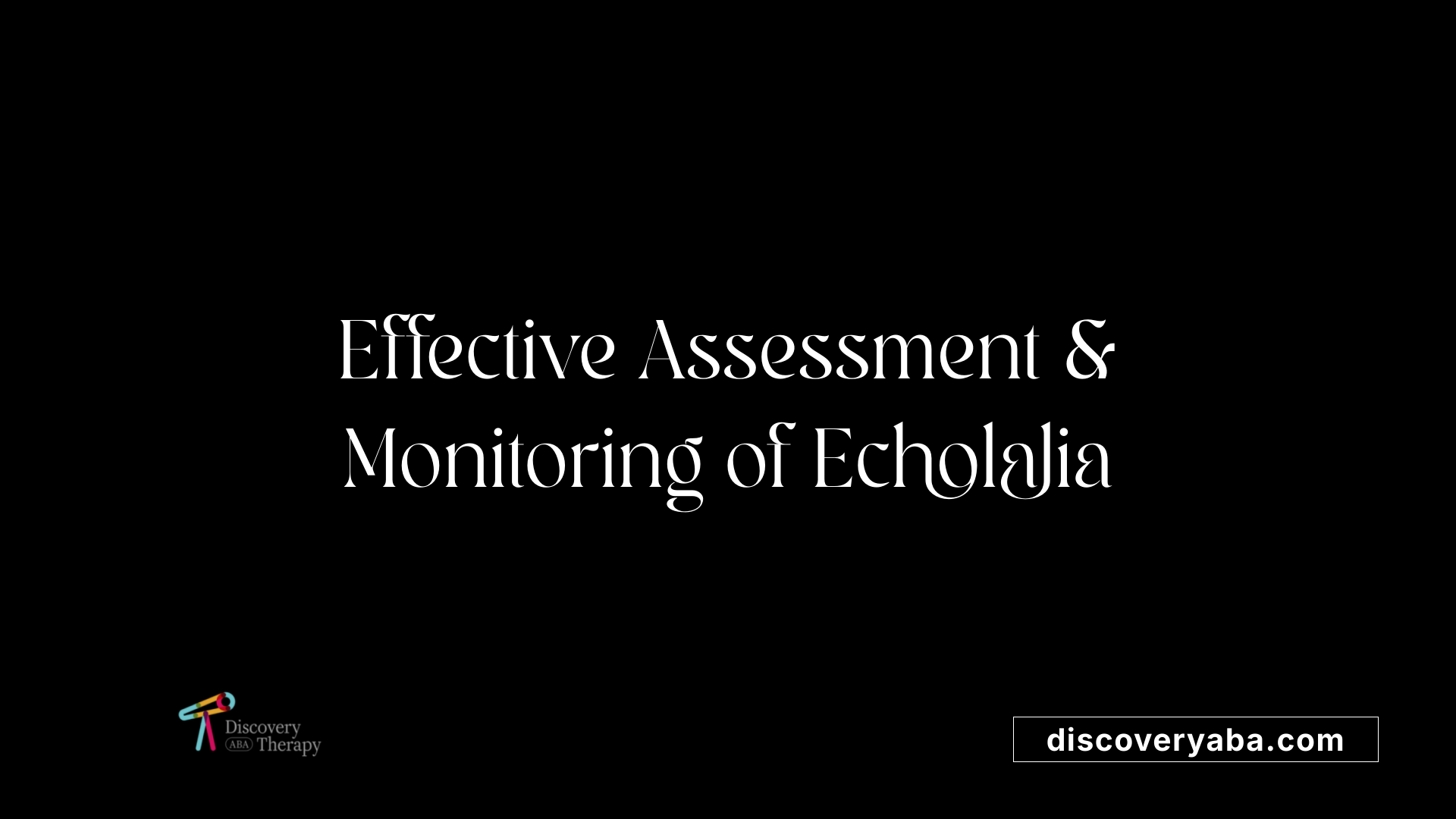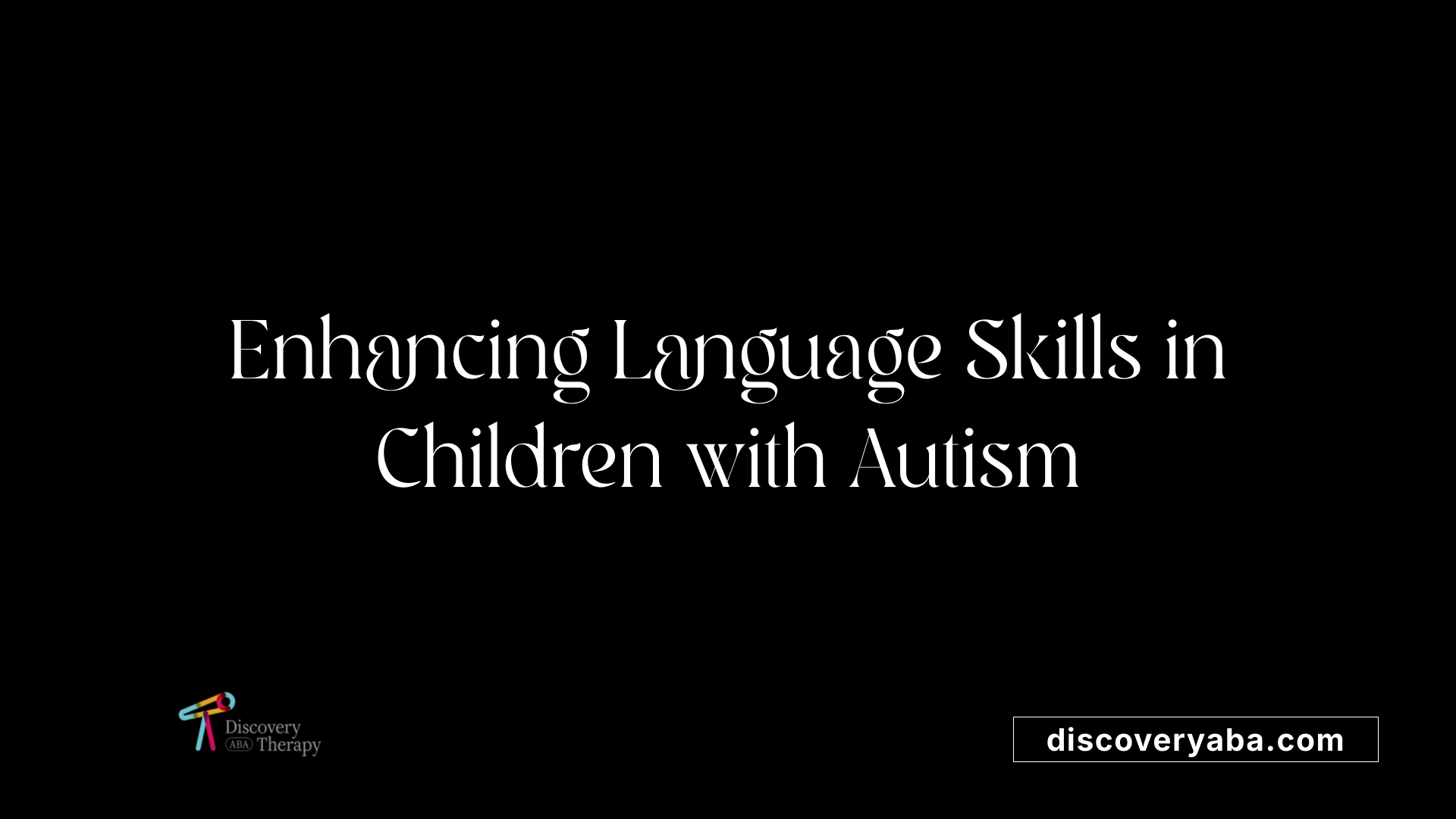How ABA helps address echolalia in autism
Innovative Strategies in Autism Intervention

Understanding the Role of ABA in Managing Echolalia
Echolalia, characterized by the repetitive repetition of words or phrases, is a common feature observed in children with autism spectrum disorder (ASD). While it can serve functional roles such as self-regulation or language processing, it often poses challenges to effective communication. Applied Behavior Analysis (ABA) offers a structured, evidence-based approach to reducing non-functional echolalia and fostering meaningful language development. This article explores how ABA techniques are employed to address echolalia, supported by empirical research and practical strategies for caregivers and clinicians alike.
ABA’s Approach to Enhancing Communication in Children with Autism
ABA therapy employs various techniques to support children with autism in developing effective communication skills. One such method is Discrete Trial Training (DTT), which breaks down complex behaviors into simple, repeated steps, reinforced with positive feedback. Echoic training focuses on teaching children to imitate sounds or words, transforming echolalia from a repetitive behavior into functional speech.
Another important strategy is Functional Communication Training (FCT), aimed at replacing echolalia with purposeful communication. For example, children might learn to use gestures or simple words to express their needs, reducing reliance on repetitive phrases. Visual supports like communication boards and visual schedules are also incorporated to help children understand language concepts and navigate social interactions better.
A study involving three children with ASD in China demonstrated that tact training, a type of intervention where children learn to label objects or actions, significantly reduced echolalia and fostered independent use of language. This training involved model prompts that temporarily interrupted echolalic behavior, encouraging the child to produce appropriate tacts. The effects were maintained for at least seven weeks, showing long-term benefits.
Overall, ABA therapy's structured approach, which includes modeling, prompting, reinforcement, and visual aids, helps children transition from repetitive echolalia to meaningful, spontaneous speech. By building on functional communication strategies, ABA supports children in expressing themselves more clearly and engaging socially, laying the foundation for greater independence.
Assessment and Monitoring of Echolalia in ABA Therapy

What assessment methods and progress monitoring are used in ABA therapy targeting echolalia?
In ABA therapy, evaluating echolalia involves multiple approaches to understand its functions and guide intervention strategies. Direct observation is a vital method, where therapists systematically record how often and how long echolalic behaviors occur. Tools like frequency counts, time sampling, and analyzing language samples—ideally with at least 50 utterances—help determine the child's language processing abilities, including Gestalt Language Processing.
Functional Behavior Assessment (FBA) and communication skill evaluations further clarify why echolalia occurs, whether for self-regulation, social engagement, or help in processing language. These assessments assist in tailoring interventions aimed at reducing non-functional echolalia and promoting functional speech.
Indirect strategies also play an important role. Caregiver questionnaires, checklists, rating scales, and interviews offer additional insight into the child's behavior in natural settings. These tools help identify patterns, triggers, and the severity of echolalia.
Monitoring progress involves consistent data collection, often visualized through records in electronic medical records (EMR). Regular evaluations, typically every 3 to 4 months, ensure that the intervention remains effective and appropriately adjusted. Engagement with parents and caregivers is crucial; their observations help therapists refine strategies and support the child's communication development over time.
Using these comprehensive assessment and monitoring methods, ABA practitioners can effectively track changes in echolalia and foster meaningful communication skills in children with ASD.
Techniques and Strategies for Supporting Language Development

What strategies does ABA use to support language development and manage echolalia?
Applied Behavior Analysis (ABA) employs various tailored strategies to help children with autism develop functional language skills and reduce echolalia. These interventions are personalized to each child's needs, focusing on building spontaneous and purposeful communication.
One common approach is prompting and fading, where therapists initially support children with cues to produce desired responses and gradually reduce assistance. This method encourages independence in speech and reinforces learning.
Modeling functional language is another vital technique. Therapists demonstrate clear, simple phrases to show appropriate speech patterns, helping children learn how to use language meaningfully. Visual supports like Picture Exchange Communication System (PECS) and social scripts facilitate understanding and encourage children to practice initiating and maintaining conversations.
Turn-taking exercises and practicing social scripts promote interactive communication, helping children learn the flow of natural conversation. Sensory regulation techniques are also integrated to manage sensory overload, which can interfere with learning and communication.
Behaviorally, positive reinforcement rewards desired behaviors, reinforcing the use of functional language over echolalia. Strategies like functional communication training (FCT) teach children to use specific communication methods to express needs or wants instead of repetitive echoes.
Overall, ABA's comprehensive approach combines prompting, modeling, visual supports, social skills training, and environmental modifications. These strategies aim not only to reduce repetitive echolalic patterns but also to foster flexible, meaningful communication, supporting each child's language development journey.
Tact Training: A Targeted Intervention for Echolalia Reduction
How is ABA therapy used to address echolalia in children with autism?
ABA therapy employs specific strategies to reduce echolalia and promote meaningful communication. These interventions include tact training, script training, visual supports, and modeling. By using positive reinforcement and prompting techniques, ABA encourages children to produce spontaneous and functional language.
Tact training, in particular, focuses on teaching children to label objects, actions, or pictures (tacts), helping them to replace delayed and immediate echolalia with independent naming skills. Visual cues and modeling support this process, while reinforcement strengthens correct responses.
The study involving three children in China used a multiple probe design across participants. This approach allowed researchers to assess how tact training impacted echolalia over time and across different children.
Use of tact training to address delayed echolalia
This study targeted delayed echolalia, where children repeat phrases or words after a pause. Through tact training, children learned to form functional labels for their environment, reducing the reliance on rote repetitions.
Results showed a significant decrease in echolalic behavior and an increase in appropriate tacts across all participants. These effects persisted for up to 7 weeks post-intervention, suggesting long-term benefits.
Study involving children in China
This research included three young children with ASD, showcasing the effectiveness of tact training in diverse populations. The multiple probe design provided clear evidence that the intervention contributed to lasting changes in communication behaviors.
Long-term effects and maintenance
One of the most promising outcomes was the maintenance of the improvements over several weeks. This indicates that tact training not only reduces echolalia temporarily but also helps establish functional language skills that last.
This evidence supports the idea that tact training can serve as an effective replacement skill, promoting more natural and spontaneous communication for children with ASD.
Empirical Evidence Supporting Tact Training in Echolalia Reduction
What does research say about ABA interventions like tact training for reducing echolalia?
A recent study involving three children with autism spectrum disorder (ASD) in China provides valuable insights into how tact training can help decrease echolalia and promote functional language skills.
The study utilized a multiple probe across participants design, a common research method in behavioral studies, to assess the intervention's effectiveness over time and between individuals. This approach allowed researchers to observe changes in echolalia levels before, during, and after the implementation of tact training.
Results showed a significant reduction in echolalia among all three children, accompanied by an increase in appropriate tacts — spontaneous labels of objects or actions. Notably, the improvements persisted for at least seven weeks post-intervention, demonstrating the long-lasting impact of the training.
The success of tact training was largely attributed to the use of model prompts, which served to interrupt the repetitive echolalic responses and guide children toward independent, functional language use. During training, the transfer of stimulus control from echoic prompts (repetitive mimicry) to tacts (labeling using words or phrases) played a crucial role in fostering autonomous communication behaviors.
This study adds to the growing body of evidence supporting ABA techniques, such as tact training, as effective strategies to reduce problematic echolalia and encourage meaningful language development in children with ASD. Its findings reinforce the importance of consistent, targeted interventions for lasting behavioral change.
The Functional Role of Echolalia in Children with Autism
 Echolalia, a common behavior among children with autism, involves the repetition of words or phrases and can take several forms. Immediate echolalia occurs right after hearing a phrase, while delayed echolalia involves repetitions after some time has passed. Interactive echolalia involves responses during conversations, whereas mitigated echolalia includes modified repetitions that serve specific functions.
Echolalia, a common behavior among children with autism, involves the repetition of words or phrases and can take several forms. Immediate echolalia occurs right after hearing a phrase, while delayed echolalia involves repetitions after some time has passed. Interactive echolalia involves responses during conversations, whereas mitigated echolalia includes modified repetitions that serve specific functions.
Understanding why children with autism engage in echolalia is crucial for supporting their communication development. This behavior often serves various functions, such as self-stimulation, self-talk, or processing language. Children may use echolalia to ask for items, initiate interactions, draw attention, protest, or respond to questions like yes/no inquiries.
Additionally, echolalia can be a tool for self-regulation, helping children manage stress, sensory overload, or emotional states. It may also function in language processing, enabling children to practice words and phrases they are learning. Recognizing these roles helps caregivers and therapists develop targeted strategies, such as modeling functional language and embedding visual supports, to promote spontaneous speech and reduce reliance on echolalia.
By understanding the diverse functions of echolalia, interventions can be tailored to reinforce its positive uses while guiding children towards more meaningful and independent communication. Building on the natural communicative intent behind echolalic responses allows for the development of functional speech skills that support social and language development in children with autism.
Supporting Families and Caregivers in Managing Echolalia

How can caregivers help reduce echolalia in children with autism?
Caregivers play a vital role in helping children with autism develop more functional communication skills and manage echolalia effectively. One effective approach is modeling appropriate responses. By consistently demonstrating how to respond to certain prompts or questions, caregivers can encourage children to adopt similar, purposeful communication behaviors.
Using prompts and starter sentences can guide children away from echolalic responses and toward more spontaneous speech. For instance, instead of echoing a phrase, a caregiver might encourage the child to express their needs or thoughts clearly by prompting with simple, guided questions.
In addition to modeling, integrating visual supports such as Picture Exchange Communication Systems (PECS), visual schedules, or signing can help children understand and use alternative communication methods. These supports not only facilitate communication but also give children opportunities to practice and become more independent in their interactions.
Gradually fading prompts and using reinforcement strategies are important to encourage consistent behavior change. Reinforcing attempts at functional communication across different settings and over time increases the likelihood of generalization.
Recognizing echolalia as an often purposeful behavior rather than a purely problematic one enables caregivers to build on the child's existing communication skills. By focusing on what the echolalic speech might be serving—such as self-stimulation or social engagement—caregivers can tailor interventions that support meaningful language development.
In sum, fostering a supportive environment where prompts are used wisely, visual supports are incorporated, and reinforcement is consistent helps children transition from echolalia to more spontaneous and functional language use. This approach not only reduces problematic repetitions but also empowers children to communicate more effectively and confidently.
Enhancing Communication and Long-term Outcomes
Through targeted interventions like tact training, strategic assessment, and family involvement, ABA therapy offers promising avenues for reducing echolalia and promoting functional language skills in children with autism. As research continues to support these methods, clinicians and caregivers can work collaboratively to create supportive environments that foster meaningful communication, independence, and improved quality of life for children on the spectrum.
References
- Echolalia - StatPearls - NCBI Bookshelf
- The Effects of Tact Training on Echolalia in Children with Autism ...
- Understanding Echolalia in Autism: Why It Happens and How to Help
- Echolalia and Autism - Golden Care Therapy
- Echolalia - StatPearls - NCBI Bookshelf
- Echolalia - PubMed
- Echolalia: What Is It, Causes, Signs, Symptoms, and More | Osmosis
- Echolalia: Types, Causes & Treatment in Kids & Adults - Sounderic
- How ABA Therapy Can Improve Communication Skills in Children
Does Your Child Have An Autism Diagnosis?
Learn More About How ABA Therapy Can Help
Find More Articles
Contact us
North Carolina, Nevada, Utah, Virginia
New Hampshire, Maine
Arizona, Colorado, Georgia, New Mexico, Oklahoma, Texas
.avif)




































































































